Last Updated: 1 year ago
If you live on Earth, you’ve probably noticed that cats come in all weird and wonderful colors.
Sure, maybe there are no pink or green kitties (unless you dye them), but there are plenty of other variations!
Some colors are incredibly common when it comes to cats, and others are very rare! If you look at the animal world, one of the most common coat colors is brown.
However, when you specifically look at cats, brown is one of the rarest coat colors. By brown, we don’t mean brown patches or markings, but pure brown.
Why is this coat color that is so common in other animals so rare in cats? Brown cats have to have a brown gene variant!
This isn’t as common as you might think, so brown cats are a rarity in the world. If you feel the need to know more, then just stick around.
Understanding What Determines The Coat Color Of A Cat

No point in diving into the deep end yet, so let’s start with the basics – what determines coat coloring?
The answer is based in science and genetics, just like it is for humans and other living things. Melanin determines the coat color of a cat.
This is a type of pigment that has two structural components – pheomelanin (responsible for yellow and red coloring), and eumelanin (responsible for black and brown coloring).
Genes will have a high prevalence of either pheomelanin or eumelanin, which then determines the color of the animal’s coat.
Cats with genes that have a high prevalence of pheomelanin will probably have red coloring, while ones with eumelanin will most likely be black.
However, there are also cats that have recessive genes. In these cases, there will be various combinations of the two melanin structures, and coloring can be different.
Are Brown Cats Rare?
So, why exactly are brown cats rare? Well, these cats have a higher prevalence of eumelanin.
Not only that, but they also have the feline primary gene for coat color B/b/b1. The “B” refers to black, but the “b” and “b1” colors are recessive, and are brown variants.
As such, a reduced amount of eumelanin is required to produce brown cats.
The fascinating part? The gene that impacts the production of black pigment is different in different species.
In cats, researchers have “identified two mutations in this gene that cause different variations of brown coat colors in cats.”.
So, the brown color we all love isn’t just a mutation, but it’s rare, and we can understand how it actually works
Brown Cat Variants
Let’s take a look at the brown variants below to get a better understanding of this.
Chocolate Cats

To recap, there are two brown variants. Chocolate brown is one of them – it’s “b”.
Black cats will have the genotype B/B. This means that they are not able to have brown offspring, as they have no way of displaying their brown coloration.
However, cats with the genotype B/b do have the recessive brown “b” gene. This means that they have the potential to have brown offspring, but also black.
The cats with this particular genotype are the ones that are the ones with the special brown chocolate coloration.
Cats with this genotype are able to transmit their coloration variant to 50% of their offspring. So, if two cats with this genotype mated, 25% of their kittens could also have the chocolate coloration.
In order for a cat to have all brown offspring, they need to have the b/b genotype and be a chocolate cat.
Cinnamon Cats

Cinnamon cats are perhaps the lesser known cousin of the brown cat group.
These cats must have the b1/b1 genotype in order to have this coloration.
When they mate, they are very likely to transmit this beautiful cinnamon brown shade to their offspring.
A cat with a genotype of b/b1 is more likely to pass their cinnamon coloration onto their offspring (50%).
If two cats with this genotype mate, then 25% of their offspring are likely to inherit the coloration.
Diluted Browns
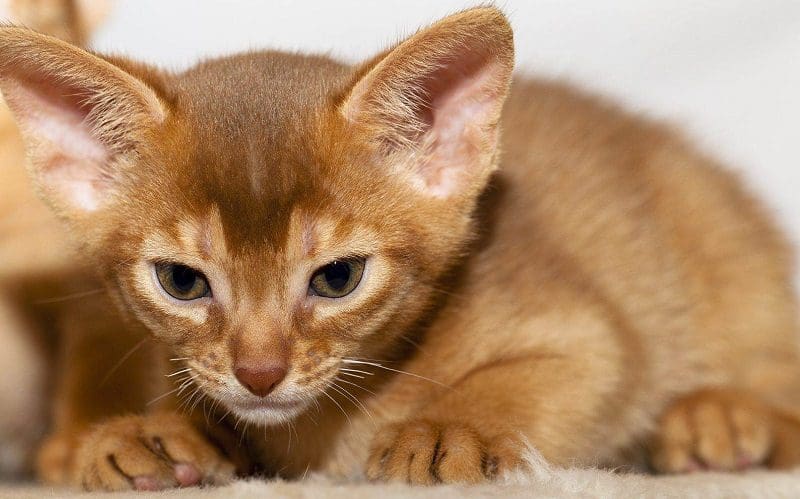
There are two more important colors to cover in this section – fawn and lilac. Fawn, which is a very light caramel color, is considered to be one of the rarest shades.
In most cases, only purebred cats will have this coloration. This coloration is a diluted variation of the beautiful cinnamon color. However, that’s not all.
In order for this color to happen, the dense pigment gene D/d has to be present. This gene will lighten the color of the fur to make it even more pale.
Why is that so interesting? That gene is also a recessive gene! In other words, both parents have to have the d/d gene in order to produce a fawn-colored kitten.
All of the above also applies to the stunning “lilac” or “lavender” coloring that some cats have.
This color, however, is a variation of the chocolate brown weather than the fawn. Lilac coloring is incredibly rare, and also typically found in cats that are purebred.
Are Black Cats Able To Turn Brown?
Technically yes, but they shouldn’t! A black cat might turn a chocolate brown color because they are not able to produce enough melanin.
This is called Tyrosine deficiency. While it isn’t common, it can happen, and you should take your pet to the vet if you suspect it.
In most cases, a black cat isn’t actually turning brown. More often than not, the change in coloration is just due to light!
A black cat that walks out into the bright sunlight might look like a brown cat because of how the light affects the coloring.
Black cats don’t have the brown gene, so you can just blame sun exposure for making your cat look different.
This apparent change in color is most common with cats that have longer hair, such as the black Maine Coon.
If you have spent a lot of time outside in the sun, you’ve probably noticed that your hair will get bleached by it!
The same will happen with cats, so it’s nothing to worry about. Just be sure to keep your cat safe, especially in the height of summer when the temperatures are soaring.
Which Cat Breeds Can Have Brown Coats?
Now that we’ve covered how brown cats exist, you’re probably wondering which breeds are often brown.
Well, have no fear – there are five cat breeds that often have brown coats! Let’s take a look at them below.
#1 Havana Brown
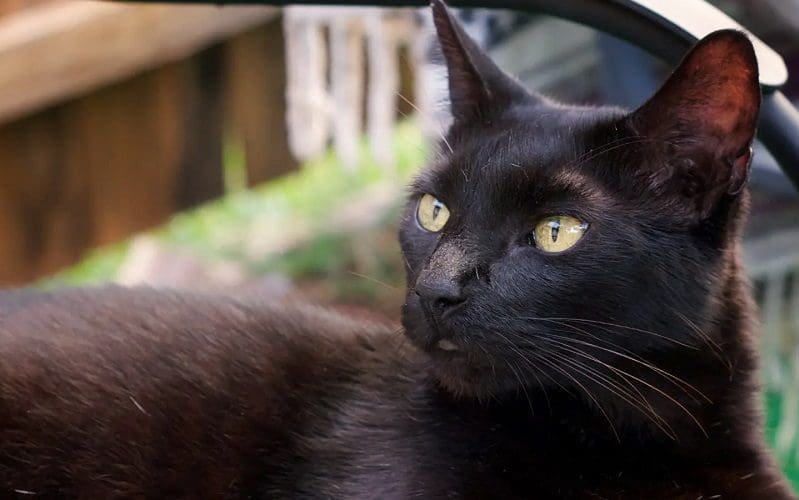
First up is the Havana Brown! These cats are absolutely gorgeous and are the only real breed that can actually be called “true chocolate”.
There are thought to only be 1,000 or fewer Havana Brown cats in the world.
Considering there are more than 200 million cats around the globe, that’s a pretty amazing number. Three distinct breeds were bred together to create the Havana Brown.
Those are the Siamese cats, Russian Blues, and the black domestic shorthair. As such, the Havana Brown is not a naturally occurring breed!
A Havana Brown cat will have chestnut-colored faces, nose and whiskers, which really sets them apart from other breeds.
The CFA has this to day about Havana Brown cats: “distinctive muzzle shape, coat color, large forward-tilted ears, and striking green eyes set it apart from other breeds.”
#2 York Chocolate
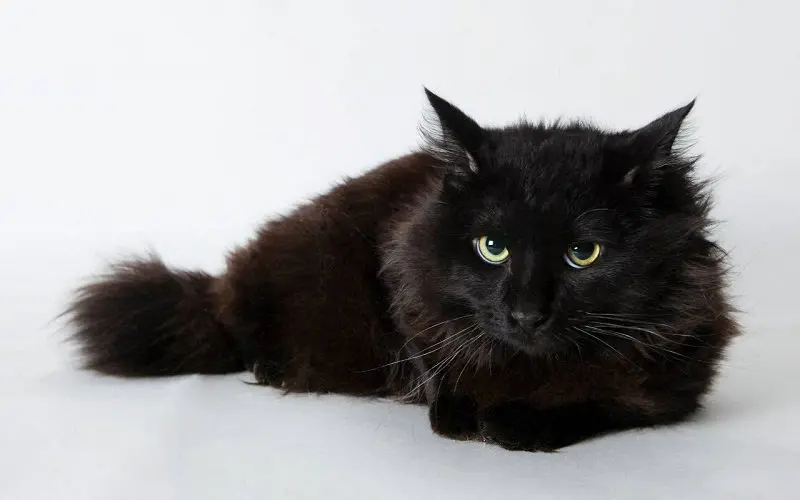
York Chocolate cats have beautiful rich brown coats.
They have darker coloring than the Havana Brown, and have semi-longhair coats.
Only making their first appearance in the 80s, this is a very new breed of cat and hasn’t even been registered as such by many associations.
These cats can have unique coloring. Many will have a chocolate brown coat, but others will have either bicolor and white, or even bicolor chocolates and even lilac!
Not only that, but the coloring of these cats often gets darker as the animal matures.
#3 Burmese Cat

Third on the list is the beautiful Burmese cat. This breed of cat was first introduced to the United States in the 1930s due to selective breeding.
Since then, it has become immensely popular and is a favorite among many. The solid brown coloration was isolated in this breed to keep colors pure.
This cat actually comes in four delightful colors – pale gray, rich dark brown, warm beige, and a medium gray with fawny undertones.
No matter the color, these cats are absolutely beautiful and something special. Just look at those golden eyes!
#4 Oriental Shorthair
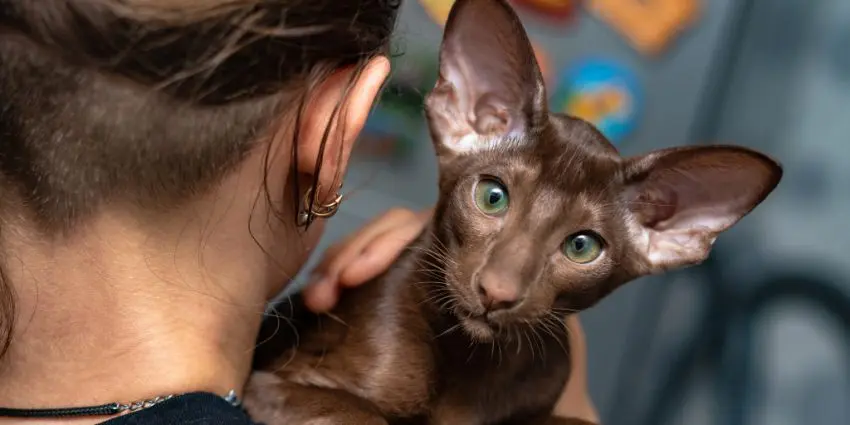
Fourth on the list is the unique but beautiful Oriental Shorthair.
With its beautiful long legs and long face, this breed was “developed to explore all the possibilities of color and pattern”.
Seeing as there are more than 600 unique colors and patterns associated with this breed, we can say with confidence that the goal was achieved.
There are even variations with coat length! You can’t get any more varied than that. Since there are more than 600 variations around, it would come as no surprise to learn that this breed has it all.
There are chocolate, cinnamon, lilac, and fawn-colored cats out there, and they are too beautiful to pass up.
Chances are, you will be able to find an Oriental Shorthair with every naturally occurring coat color under the sun if you look hard enough. There are even tortoise shell colors!
#5 Brown Tabby Cat
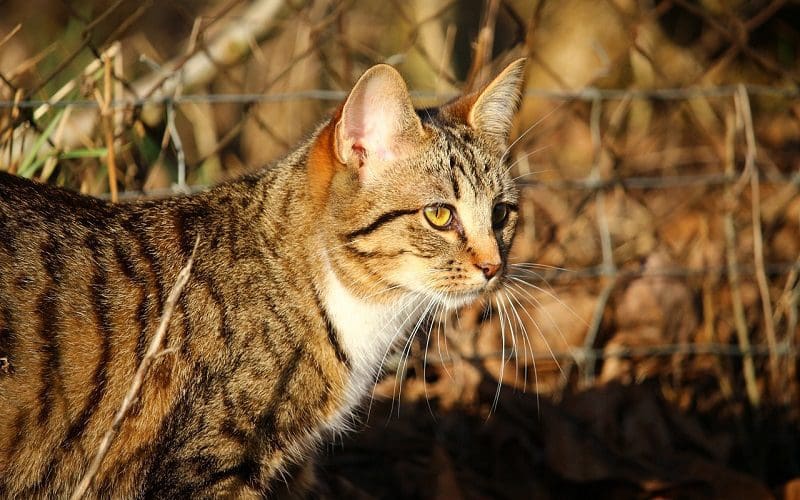
Last on the list is the humble brown tabby cat. Yes, “tabby” cats aren’t actually a specific breed of cat, but it’s still worth mentioning!
The term tabby actually refers to the animal’s markings. These markings can be strips, spots, or anything in between.
Most tabby cats have that distinctive M of markings on their heads, and often have white on their paws, bellies, or chests.
Nonspecific breed and markings aside, there are plenty of brown tabby cats around! They are especially common in some countries where there are lots of strays – like Greece.
Their beautiful markings can make them stand out on their own and look unique compared to the other brown cats on the list!
Final Thoughts
So, the mystery of the brown cat is now (hopefully) solved. Brown cats are rare thanks to their unique recessive genes and genotypes!
There are two structures of melanin – pheomelanin and eumelanin, which both impact the coloration of a cat.
A high prevalence of eumelanin will produce cats that are black, while a high prevalence of pheomelanin will produce red or yellow cats.
Depending on the recessive genes in an animal, their offspring can look the same as parents, or incredibly different!
However, these colorations are far more common in some breeds, where the animals have carefully been bred to create these colors.
There are four primary breeds of cat that have brown coats – the Havana brown, York chocolate, Burmese, and Oriental shorthair. The brown tabby cat is an honorable mention, as tabby cats aren’t actually a specific breed!
Hopefully this article has helped you understand the mystery behind brown cats and why they’re so rare a little more. Just remember – all cats are precious, no matter their color!
